Reboots
Space 2099
On 9th February 2012, ITV Studios America and HDFILMS announced a "reboot" of Space: 1999, named "Space 2099" (no colon). Executive producer Jace Hall stated "While we are indeed re-imagining the franchise and bringing something new and relevant to today's audiences, I feel strongly that some of the overall tones set by the original SPACE: 1999 television show represent an exciting platform to explore possibilities." There was some hints on the new direction at the Alphacon 2012 convention (September 2012). The last official announcement was May 2014, but there was no new information. In December 2015 we learned the project is no longer being pursued, but there has been no formal announcement.
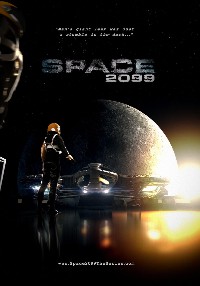

The production company was HDFILMS. Executive producer was Jace Hall, the head of HDFILMS.
The new production did not contact Gerry Anderson, Christopher Penfold, Brian Johnson or any of the original crew. As this is a North American based production, it is unlikely the British-based crew will have any significant creative involvement. For publicity purposes one or more names may have been attached to the project, even just as an endorsement, but the producers (and ITV) were under no obligation to do so.
None announced. HDFILMS previous reboot series, V, featured cameos of cast from the original series. The cast members who have a base in the US (Landau, Bain and Tate) could have been approached for cameos, but the UK cast was unlikely to be. At the Alphacon 2012 convention (September 2012), there was a clear hint that Juliet Landau (actress daughter of Landau and Bain) had been contacted.
There was no mention of characters or character names.
The first series had a distinctive orchestral theme by Barry Gray, and made use of a wide variety of electronic and orchestral library tracks. The second series had a jazz-influenced score by Derek Wadsworth. The publishing rights to the original music belongs to Sony/ATV Music Publishing, so HDFILMS were unlikely to use it.
Most fans will hope for an orchestral score in the style of Barry Gray, which perhaps may quote some of the themes (as Star Trek the Next Generation did).
This isn't clear yet.
Network TV still dominates in terms of quantity and exposure, but it is much diminished since the 1970s. The highest quality series have been on cable for many years. The original series attempted to secure network TV, but had to use syndication. It still suffered from much interference, trying to appeal to network TV audiences. Cable networks such as HBO and Showtime have won awards and critical acclaim for original programming that would not be possible on network TV.
Another possibility is online. Many consider internet on-demand viewing to be the future. HDFILMS is "primarily focused on creating premium online content", but was also involved (with Warner Bros. Television) in the US network TV series V, another reboot of an old series. Netflix have had critical and popular hits with original programming made for internet video streaming (House of Cards, Orange is the new black), as have Amazon.
On 23 January 2014, Jace Hall stated As of last week, ITV has initiated discussions with various networks/distributors/destinations in regard to what will be the right home for this tremendous series.
None known. As of 2016, it appears to be dead. Many projects, including a film of Gerry Anderson's UFO, have become stuck in "development hell". The original Space: 1999 also got stuck in development hell in 1973 before being resurrected.
Many old series have been rebooted. Some have been successful (Battlestar Galactica), many have been dire (Thunderbirds). Jace Hall and HDFILMS were behind another reboot, V (2009-2011). V had a strong opening, and got an Emmy nomination for special effects, but received some criticism for being formulaic.
Gerry Anderson rebooted his own series Captain Scarlet. All the popular vehicle designs were changed, in order to generate more merchandise revenue, and the Barry Gray music was replaced. Thunderbirds was also rebooted as a part-CGI series, with altered designs and music. Space 2099 will no doubt have the same pressures, although it would be more popular with fans of the original if they retained the Eagle design and, say, reworked the original Gray themes.
This Space 2099 series was not related to Eric Bernard's Space 2099 / Moonbase Alpha Legacy project, which is unofficial and not endorsed by ITV.
There was an earlier project around 2008-2010 headed by SFX supervisor Tim Miller at Blur Studio (they worked on the space scenes of Avatar and the title sequence of Girl with the Dragon Tatoo). Concept art on the web (by John Wallin Liberto, Chuk Wojtkiewicz and John Park) shows Eagles with heavy guns mounted on them and large battle scenes with aliens, suggesting the concept was heavily influenced by Battlestar Galactica.
Space: 1999 had stand-alone episodes that could be (and were) shown in any order. Space: 2099 is much more serialized in story than Space: 1999. Character progression and story telling can now have meaningful long arcs and significant impact.
(Jace Hall, January 2014). He states that there will be plot twists.
The announcement states it was a "complete reimagining". We are not remaking Space 1999
The official website FAQ states that while there will be some familiar elements from Space:1999, Space: 2099 represents a new vision and encapsulation of the intentions and key axioms that made Space: 1999 so unique and wonderful
Jace Hall stated he would not reveal story content yet (probably under commercial restrictions from ITV).
The promotional images give some hints that there are some common elements- the Moon, Alpha, the Eagle nose cones, sleeve colours, and a large spaceship probe (like the Meta Probe).
The promotional images use the quote "Man's giant leap was just a stumble in the dark...". This is a reworking of Koenig's line from Breakaway.
The Moon was clearly an important element but we don't know if the story would involve the Moon travelling through space. The adventures could be on a spaceship, although that would be rather too close to Star Trek and many other series. There were many story possibilities for moving the Moon through space, some of which were touched upon in the original series. Will the Moon play the same role that it did in Space: 1999, the answer is that it will not. It will be present, and it has a purpose, but it will not play the exact same role that it did in Space: 1999.
Comments at the Alphacon 2012 convention suggested that the series would be Earth-based, in the aftermath of the Moon leaving, but Jace Hall has said this is not correct. There was a strong suggestion that it does not involve the Moon travelling through space, which indicates a spaceship or asteroid.
Test effects footage at the convention showed the Eagle-like design shown in the posters hovering over a futuristic city, dated 14 September 2099. This was just test computer graphics, not a story element. Jace Hall stated this was not the Eagle (although the version in the posters had the label "Eagle 01". He suggested something closer to the original design of the Eagle might appear.
Most fans of the original series would probably prefer a continuation of the series (as the original Star Trek was updated in Star Trek The Next Generation). In a sense, Space: 1999 already went through one continuation, when the format was revised for the second series- but those changes weren't popular either. However, it would win support if it captured key design elements (the Eagle, the stark white modular Alpha set design) and story themes (the journey through space is uncontrolled and unwilling, and the stories are mysterious and dark but not neatly resolved or explained at the end).
The official website FAQ stated these themes (summarised):
The true sense of fear, awe and discovery when dealing with the unknown. A common story theme of the original series was the mystery of the unknown. Another quote asserts that the goal is to evoke
that sense of awe, fear and incredible spectacle that is the unknown, unexplored universe, which sounds very much in the spirit of the original show.
The human experience ... at extreme disadvantage being a driving force in the cooperation of disparate interests and agendas for the purposes of survival.The Alphans were almost always at extreme disadvantage of powerful forces and advanced alien technology. The Alphans were almost always cohesive and mutually supportive. With the exception of Simmonds in two episodes, there was little sense that they otherwise had different agendas.
The very real near-future plausibility of the technology depicted.. This is a central point of the series, and indeed the title.
The FAQ further mentions plausibility
as a key concern, specifying the technology portrayed, human reactions in the story, and the look and feel
. Hopefully this doesn't signify the "shaky cam" technique used to evoke documentary-type filming.
From a later interview: Space: 2099's goal is not to attempt to re-tell the specific story of Space: 1999. We are not trying to make some "dark and gritty" version of Space: 1999.

The "horizon" poster. We see an astronaut, the front of an Eagle-like ship, and the Moon beyond. The reflective surfaces are very different from the original series aesthetic. The Eagle has had a significant redesign, with a wide flat body. The location could be a space station above the moon, like the Space Dock in the original, but this clearly has surface gravity.

The "under construction" poster. The big spaceship with cranes is presumably the Meta Probe being built. If so, it indicates Space 2099 will follow the storyline from Breakaway.
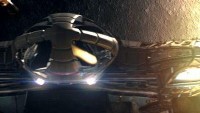
The re-imagined Eagle. The nose cone is instantly recognizable, but the body has changed significantly.
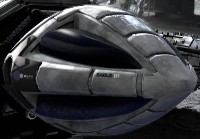
Another view of the nose cone. Here we see a strange glass-like bubble within the inset windows. It is labelled "Eagle 01", and "Alpha" (the Alpha insignia is one large sphere and one small one- not the trapezoid design from the original series).
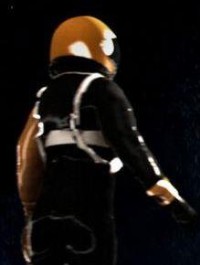
The astronaut. The helmet is yellow like the original series, but the spacesuit is black... except for the left sleeve. In the original series, the uniform left sleeves were coloured to indicate the section, but the spacesuits were all identical orange. This astronaut has an orange sleeve- the orange colour in the original series indicated he was a pilot. Note the suit has no oxygen back-pack.
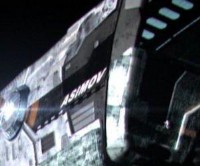
The giant spaceship being built (probably corresponding to the Meta Probe) is named Asimov, after the science fiction writer (who wasn't fond of the original series). The front end looks like it was influenced by Chris Foss designs (as was Martin Bower when he created the original series models).

A detail of the spaceship being built. The framework and tubes is one design element copied directly from the original series, particularly the Ultra Probe (from Dragon's Domain).

The solar panels along both sides look very like the original Meta Probe design from Breakaway. It is unlikely that the panels would be in place during construction on the moon, because they would need extra bracing for lunar gravity- if they were attached in space, they could save significant weight.
Contents copyright Martin Willey; images copyright HDFILMS/ ITV Studios America